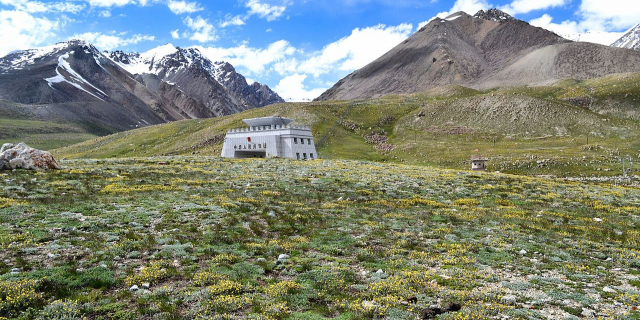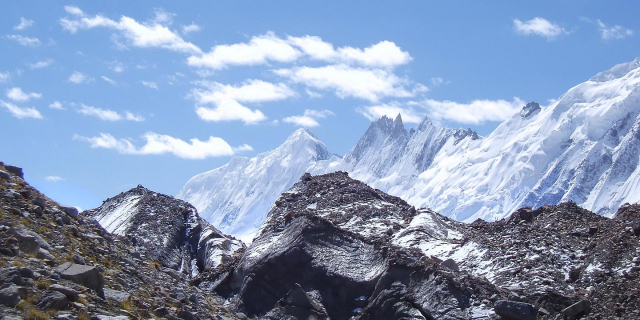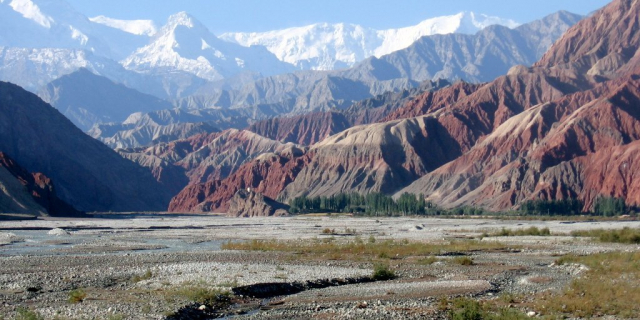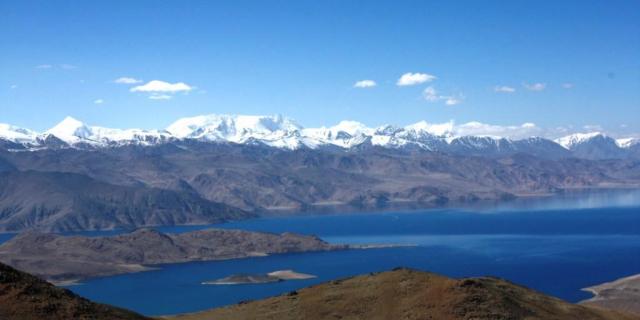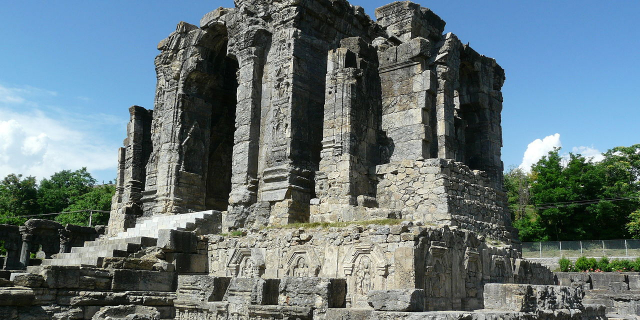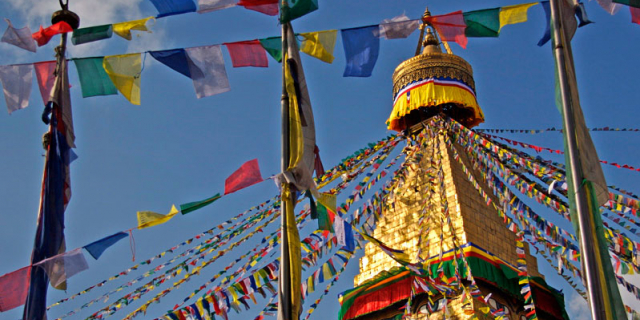Uyghurs
Context of Uyghurs
The Uyghurs (English: WEE-goorz or OOY-goorz), alternatively spelled Uighurs, Uygurs or Uigurs, are a Turkic ethnic group originating from and culturally affiliated with the general region of Central and East Asia. The Uyghurs are recognized as native to the Xinjiang Uyghur Autonomous Region in Northwest China. They are one of China's 55 officially recognized ethnic minorities. The Uyghurs are recognized by the Chinese government as a regional minority and the titular people of Xinjiang.
The Uyghurs have traditionally inhabited a series of oases scattered across the Taklamakan Desert within...Read more
The Uyghurs (English: WEE-goorz or OOY-goorz), alternatively spelled Uighurs, Uygurs or Uigurs, are a Turkic ethnic group originating from and culturally affiliated with the general region of Central and East Asia. The Uyghurs are recognized as native to the Xinjiang Uyghur Autonomous Region in Northwest China. They are one of China's 55 officially recognized ethnic minorities. The Uyghurs are recognized by the Chinese government as a regional minority and the titular people of Xinjiang.
The Uyghurs have traditionally inhabited a series of oases scattered across the Taklamakan Desert within the Tarim Basin. These oases have historically existed as independent states or were controlled by many civilizations including China, the Mongols, the Tibetans and various Turkic polities. The Uyghurs gradually started to become Islamized in the 10th century and most Uyghurs identified as Muslims by the 16th century. Islam has since played an important role in Uyghur culture and identity.
An estimated 80% of Xinjiang's Uyghurs still live in the Tarim Basin. The rest of Xinjiang's Uyghurs mostly live in Ürümqi, the capital city of Xinjiang, which is located in the historical region of Dzungaria. The largest community of Uyghurs living outside of Xinjiang are the Taoyuan Uyghurs of north-central Hunan's Taoyuan County. Significant diasporic communities of Uyghurs exist in other Turkic countries such as Kazakhstan, Kyrgyzstan, Uzbekistan and Turkey. Smaller communities live in Saudi Arabia, Jordan, Australia, Russia and Sweden.
Since 2014, the Chinese government has subjected Uyghurs living in Xinjiang to widespread human rights abuses, including forced sterilization and forced labor, in what has been described as genocide. Scholars estimate that at least one million Uyghurs have been arbitrarily detained in the Xinjiang internment camps since 2017; Chinese government officials claim that these camps, created under CCP general secretary Xi Jinping's administration, serve the goals of ensuring adherence to Chinese Communist Party (CCP) ideology, preventing separatism, fighting terrorism, and providing vocational training to Uyghurs. Various scholars, human rights organizations and governments consider abuses perpetrated against the Uyghurs to amount to crimes against humanity or genocide.
More about Uyghurs
- Population 12314800
Read more
Read lessUyghur princes from Cave 9 of the Bezeklik Thousand Buddha Caves, Xinjiang, China, 8th–9th century AD, wall paintingThe history of the Uyghur people, as with the ethnic origin of the people, is a matter of contention.[1] Uyghur historians viewed the Uyghurs as the original inhabitants of Xinjiang with a long history. Uyghur politician and historian Muhammad Amin Bughra wrote in his book A History of East Turkestan, stressing the Turkic aspects of his people, that the Turks have a continuous 9000-year-old history, while historian Turghun Almas incorporated discoveries of Tarim mummies to conclude that Uyghurs have over 6400 years of continuous history,[2] and the World Uyghur Congress claimed a 4,000-year history in East Turkestan.[3] However, the official Chinese view, as documented in the white paper History and Development of Xinjiang, asserts that the Uyghur ethnic group formed after the collapse of the Uyghur Khaganate in 840, when the local residents of the Tarim Basin and its surrounding areas were merged with migrants from the khaganate.[4] The name "Uyghur" reappeared after the Soviet Union took the 9th-century ethnonym from the Uyghur Khaganate, then reapplied it to all non-nomadic Turkic Muslims of Xinjiang.[5] Many contemporary western scholars, however, do not consider the modern Uyghurs to be of direct linear descent from the old Uyghur Khaganate of Mongolia. Rather, they consider them to be descendants of a number of peoples, one of them the ancient Uyghurs.[6][7][8][9]
Early historyDiscovery of well-preserved Tarim mummies of a people European in appearance indicates the migration of a European-looking people into the Tarim area at the beginning of the Bronze Age around 1800 BC. These people may have been of Tocharian origin, and some have suggested them to be the Yuezhi mentioned in ancient Chinese texts.[10][11] The Tocharians are thought to have developed from the Indo-European speaking Afanasevo culture of Southern Siberia (c. 3500–2500 BC).[12] A study published in 2021 showed that the earliest Tarim Basin cultures had high levels of Ancient North Eurasian ancestry, with smaller admixture from Northeast Asians.[13] Uyghur activist Turgun Almas claimed that Tarim mummies were Uyghurs because the earliest Uyghurs practiced shamanism and the buried mummies' orientation suggests that they had been shamanists; meanwhile, Qurban Wäli claimed words written in Kharosthi and Sogdian scripts as "Uyghur" rather than Sogdian words absorbed into Uyghur according to other linguists.[14]
Later migrations brought peoples from the west and northwest to the Xinjiang region, probably speakers of various Iranian languages such as the Saka tribes, who were closely related to the European Scythians and descended from the earlier Andronovo culture,[15] and who may have been present in the Khotan and Kashgar area in the first millennium BC, as well as the Sogdians who formed networks of trading communities across the Tarim Basin from the 4th century AD.[16] There may also be an Indian component as the founding legend of Khotan suggests that the city was founded by Indians from ancient Taxila during the reign of Ashoka.[17][18] Other people in the region mentioned in ancient Chinese texts include the Dingling as well as the Xiongnu who fought for supremacy in the region against the Chinese for several hundred years. Some Uyghur nationalists also claimed descent from the Xiongnu (according to the Chinese historical text the Book of Wei, the founder of the Uyghurs was descended from a Xiongnu ruler),[19] but the view is contested by modern Chinese scholars.[2]
The Yuezhi were driven away by the Xiongnu but founded the Kushan Empire, which exerted some influence in the Tarim Basin, where Kharosthi texts have been found in Loulan, Niya and Khotan. Loulan and Khotan were some of the many city-states that existed in the Xinjiang region during the Han Dynasty; others include Kucha, Turfan, Karasahr and Kashgar. These kingdoms in the Tarim Basin came under the control of China during the Han and Tang dynasties. During the Tang dynasty they were conquered and placed under the control of the Protectorate General to Pacify the West, and the Indo-European cultures of these kingdoms never recovered from Tang rule after thousands of their inhabitants were killed during the conquest.[20] The settled population of these cities later merged with the incoming Turkic people, including the Uyghurs of Uyghur Khaganate, to form the modern Uyghurs. The Indo-European Tocharian language later disappeared as the urban population switched to a Turkic language such as the Old Uyghur language.[21]
The early Turkic peoples descended from agricultural communities in Northeast Asia who moved westwards into Mongolia in the late 3rd millennium BC, where they adopted a pastoral lifestyle.[22][23][24][25][26] By the early 1st millennium BC, these peoples had become equestrian nomads.[22] In subsequent centuries, the steppe populations of Central Asia appear to have been progressively Turkified by East Asian nomadic Turks, moving out of Mongolia.[27][28]
Uyghur Khaganate (8th–9th centuries) An 8th-century Uyghur Khagan
An 8th-century Uyghur KhaganThe Uyghurs of the Uyghur Khaganate were part of a Turkic confederation called the Tiele,[29] who lived in the valleys south of Lake Baikal and around the Yenisei River. They overthrew the First Turkic Khaganate and established the Uyghur Khaganate.
The Uyghur Khaganate lasted from 744 to 840.[6] It was administered from the imperial capital Ordu-Baliq, one of the biggest ancient cities built in Mongolia. In 840, following a famine and civil war, the Uyghur Khaganate was overrun by the Yenisei Kirghiz, another Turkic people. As a result, the majority of tribal groups formerly under Uyghur control dispersed and moved out of Mongolia.
Uyghur kingdoms (9th–11th centuries) Uyghur Khaganate in geopolitical context c. 820 AD
Uyghur Khaganate in geopolitical context c. 820 ADThe Uyghurs who founded the Uyghur Khaganate dispersed after the fall of the Khaganate, to live among the Karluks and to places such as Jimsar, Turpan and Gansu.[30][note 1] These Uyghurs soon founded two kingdoms and the easternmost state was the Ganzhou Kingdom (870–1036) which ruled parts of Xinjiang, with its capital near present-day Zhangye, Gansu, China. The modern Yugurs are believed to be descendants of these Uyghurs. Ganzhou was absorbed by the Western Xia in 1036.
The second Uyghur kingdom, the Kingdom of Qocho ruled a larger section of Xinjiang, also known as Uyghuristan in its later period, was founded in the Turpan area with its capital in Qocho (modern Gaochang) and Beshbalik. The Kingdom of Qocho lasted from the ninth to the fourteenth century and proved to be longer-lasting than any power in the region, before or since.[6] The Uyghurs were originally Tengrists, shamanists, and Manichaean, but converted to Buddhism during this period. Qocho accepted the Qara Khitai as its overlord in the 1130s, and in 1209 submitted voluntarily to the rising Mongol Empire. The Uyghurs of Kingdom of Qocho were allowed significant autonomy and played an important role as civil servants to the Mongol Empire, but was finally destroyed by the Chagatai Khanate by the end of the 14th century.[6][32]
IslamizationIn the tenth century, the Karluks, Yagmas, Chigils and other Turkic tribes founded the Kara-Khanid Khanate in Semirechye, Western Tian Shan, and Kashgaria and later conquered Transoxiana. The Karakhanid rulers were likely to be Yaghmas who were associated with the Toquz Oghuz and some historians therefore see this as a link between the Karakhanid and the Uyghurs of the Uyghur Khaganate, although this connection is disputed by others.[33]
The Karakhanids converted to Islam in the tenth century beginning with Sultan Satuq Bughra Khan, the first Turkic dynasty to do so.[34] Modern Uyghurs see the Muslim Karakhanids as an important part of their history; however, Islamization of the people of the Tarim Basin was a gradual process. The Indo-Iranian Saka Buddhist Kingdom of Khotan was conquered by the Turkic Muslim Karakhanids from Kashgar in the early 11th century, but Uyghur Qocho remained mainly Buddhist until the 15th century, and the conversion of the Uyghur people to Islam was not completed until the 17th century.
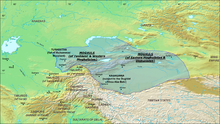 Chagatai Khanate (Moghulistan) in 1490
Chagatai Khanate (Moghulistan) in 1490The 12th and 13th century saw the domination by non-Muslim powers: first the Kara-Khitans in the 12th century, followed by the Mongols in the 13th century. After the death of Genghis Khan in 1227, Transoxiana and Kashgar became the domain of his second son, Chagatai Khan. The Chagatai Khanate split into two in the 1340s, and the area of the Chagatai Khanate where the modern Uyghurs live became part of Moghulistan, which meant "land of the Mongols". In the 14th century, a Chagatayid khan Tughluq Temür converted to Islam, Genghisid Mongol nobilities also followed him to convert to Islam.[35] His son Khizr Khoja conquered Qocho and Turfan (the core of Uyghuristan) in the 1390s, and the Uyghurs there became largely Muslim by the beginning of the 16th century.[33] After being converted to Islam, the descendants of the previously Buddhist Uyghurs in Turfan failed to retain memory of their ancestral legacy and falsely believed that the "infidel Kalmuks" (Dzungars) were the ones who built Buddhist structures in their area.[36]
From the late 14th through 17th centuries, the Xinjiang region became further subdivided into Moghulistan in the north, Altishahr (Kashgar and the Tarim Basin), and the Turfan area, each often ruled separately by competing Chagatayid descendants, the Dughlats, and later the Khojas.[33]
Islam was also spread by the Sufis, and branches of its Naqshbandi order were the Khojas who seized control of political and military affairs in the Tarim Basin and Turfan in the 17th century. The Khojas however split into two rival factions, the Aqtaghlik ("White Mountainers") Khojas (also called the Afaqiyya) and the Qarataghlik ("Black Mountainers") Khojas (also called the Ishaqiyya). The legacy of the Khojas lasted until the 19th century. The Qarataghlik Khojas seized power in Yarkand where the Chagatai Khans ruled in the Yarkent Khanate, forcing the Aqtaghlik Afaqi Khoja into exile.
Qing rule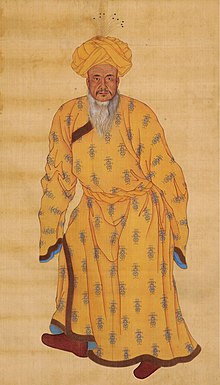 Uyghur General Khojis (-1781), governor of Us-Turfan, who later resided at the Qing court in Beijing. Painting by a European Jesuit artist at the Chinese court in 1775.[37]
Uyghur General Khojis (-1781), governor of Us-Turfan, who later resided at the Qing court in Beijing. Painting by a European Jesuit artist at the Chinese court in 1775.[37]In the 17th century, the Buddhist Dzungar Khanate grew in power in Dzungaria. The Dzungar conquest of Altishahr ended the last independent Chagatai Khanate, the Yarkent Khanate, after the Aqtaghlik Afaq Khoja sought aid from the 5th Dalai Lama and his Dzungar Buddhist followers to help him in his struggle against the Qarataghlik Khojas. The Aqtaghlik Khojas in the Tarim Basin then became vassals to the Dzungars.
The expansion of the Dzungars into Khalkha Mongol territory in Mongolia brought them into direct conflict with Qing China in the late 17th century, and in the process also brought Chinese presence back into the region a thousand years after Tang China lost control of the Western Regions.[38]
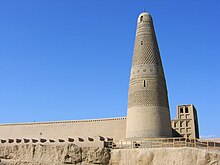 Minaret of Turpan ruler Emin Khoja, built by his son and successor Suleiman in 1777 in the memory of his father (tallest minaret in China)
Minaret of Turpan ruler Emin Khoja, built by his son and successor Suleiman in 1777 in the memory of his father (tallest minaret in China)The Dzungar–Qing War lasted a decade. During the Dzungar conflict, two Aqtaghlik brothers, the so-called "Younger Khoja" (Chinese: 霍集佔), also known as Khwāja-i Jahān, and his sibling, the Elder Khoja (Chinese: 波羅尼都), also known as Burhān al-Dīn, after being appointed as vassals in the Tarim Basin by the Dzungars, first joined the Qing and rebelled against Dzungar rule until the final Qing victory over the Dzungars, then they rebelled against the Qing in the Revolt of the Altishahr Khojas (1757–1759), an action which prompted the invasion and conquest of the Tarim Basin by the Qing in 1759. The Uyghurs of Turfan and Hami such as Emin Khoja were allies of the Qing in this conflict, and these Uyghurs also helped the Qing rule the Altishahr Uyghurs in the Tarim Basin.[39][40]
The final campaign against the Dzungars in the 1750s ended with the Dzungar genocide. The Qing "final solution" of genocide to solve the problem of the Dzungar Mongols created a land devoid of Dzungars, which was followed by the Qing sponsored settlement of millions of other people in Dzungaria.[41][42] In northern Xinjiang, the Qing brought in Han, Hui, Uyghur, Xibe, Daurs, Solons, Turkic Muslim Taranchis and Kazakh colonists, with one third of Xinjiang's total population consisting of Hui and Han in the northern area, while around two thirds were Uyghurs in southern Xinjiang's Tarim Basin.[43] In Dzungaria, the Qing established new cities like Ürümqi and Yining.[44] The Dzungarian basin itself is now inhabited by many Kazakhs.[45] The Qing therefore unified Xinjiang and changed its demographic composition as well.[46]: 71 The crushing of the Buddhist Dzungars by the Qing led to the empowerment of the Muslim Begs in southern Xinjiang, migration of Muslim Taranchis to northern Xinjiang, and increasing Turkic Muslim power, with Turkic Muslim culture and identity was tolerated or even promoted by the Qing.[46]: 76 It was therefore argued by Henry Schwarz that "the Qing victory was, in a certain sense, a victory for Islam".[46]: 72
In Beijing, a community of Uyghurs was clustered around the mosque near the Forbidden City, having moved to Beijing in the 18th century.[47]
The Ush rebellion in 1765 by Uyghurs against the Manchus occurred after several incidents of misrule and abuse that had caused considerable anger and resentment.[48][49][50] The Manchu Emperor ordered that the Uyghur rebel town be massacred, and the men were executed and the women and children enslaved.[51]
![Uyghur chieftain from Wushi, Kucha and Aksu, with his wife. Huang Qing Zhigong Tu, 1769.[52]](//upload.wikimedia.org/wikipedia/commons/thumb/a/aa/Huang_Qing_Zhigong_Tu%2C_1769%2C_Uyghur_chieftain_from_Ush%2C_Kucha_and_Aksu%2C_with_his_wife.jpg/171px-Huang_Qing_Zhigong_Tu%2C_1769%2C_Uyghur_chieftain_from_Ush%2C_Kucha_and_Aksu%2C_with_his_wife.jpg)
Uyghur chieftain from Wushi, Kucha and Aksu, with his wife. Huang Qing Zhigong Tu, 1769.[52]
![Uyghur commoners from Wushi, Kucha and Aksu. Huang Qing Zhigong Tu, 1769.[53]](//upload.wikimedia.org/wikipedia/commons/thumb/8/87/Huang_Qing_Zhigong_Tu%2C_1769%2C_Uyghur_commoners_from_Ush%2C_Kucha_and_Aksu.jpg/165px-Huang_Qing_Zhigong_Tu%2C_1769%2C_Uyghur_commoners_from_Ush%2C_Kucha_and_Aksu.jpg)
Uyghur commoners from Wushi, Kucha and Aksu. Huang Qing Zhigong Tu, 1769.[53]
![Uyghur people from Hami, in Anxi subprefecture. Huang Qing Zhigong Tu, 1769.[54]](//upload.wikimedia.org/wikipedia/commons/thumb/2/2c/Huang_Qing_Zhigong_Tu%2C_1769%2C_Uyghur_people_from_Hami_in_Anxi_subprefecture.jpg/156px-Huang_Qing_Zhigong_Tu%2C_1769%2C_Uyghur_people_from_Hami_in_Anxi_subprefecture.jpg)
Uyghur people from Hami, in Anxi subprefecture. Huang Qing Zhigong Tu, 1769.[54]
Yettishar![Uyghur people from Ili, Taleqi, Chahan and Wusu. Huang Qing Zhigong Tu, 1769.[55]](//upload.wikimedia.org/wikipedia/commons/thumb/e/e3/Huang_Qing_Zhigong_Tu%2C_1769%2C_Uyghur_from_Ili%2C_Taleqi%2C_Chahan_and_Wusu%2C_with_his_wife.jpg/175px-Huang_Qing_Zhigong_Tu%2C_1769%2C_Uyghur_from_Ili%2C_Taleqi%2C_Chahan_and_Wusu%2C_with_his_wife.jpg)
Uyghur people from Ili, Taleqi, Chahan and Wusu. Huang Qing Zhigong Tu, 1769.[55]
During the Dungan Revolt (1862–1877), Andijani Uzbeks from the Khanate of Kokand under Buzurg Khan and Yaqub Beg expelled Qing officials from parts of southern Xinjiang and founded an independent Kashgarian kingdom called Yettishar ("Country of Seven Cities"). Under the leadership of Yaqub Beg, it included Kashgar, Yarkand, Khotan, Aksu, Kucha, Korla, and Turpan.[citation needed] Large Qing dynasty forces under Chinese General Zuo Zongtang attacked Yettishar in 1876.
Qing reconquestAfter this invasion, the two regions of Dzungaria, which had been known as the Dzungar region or the Northern marches of the Tian Shan,[56][57] and the Tarim Basin, which had been known as "Muslim land" or southern marches of the Tian Shan,[58] were reorganized into a province named Xinjiang, meaning "New Territory".[59][60]
First East Turkestan RepublicIn 1912, the Qing Dynasty was replaced by the Republic of China. By 1920, Pan-Turkic Jadidists had become a challenge to Chinese warlord Yang Zengxin, who controlled Xinjiang. Uyghurs staged several uprisings against Chinese rule. In 1931, the Kumul Rebellion erupted, leading to the establishment of an independent government in Khotan in 1932,[61] which later led to the creation of the First East Turkestan Republic, officially known as the Turkish Islamic Republic of East Turkestan. Uyghurs joined with Uzbeks, Kazakhs, and Kyrgyz and successfully declared their independence on 12 November 1933.[62] The First East Turkestan Republic was a short-lived attempt at independence around the areas encompassing Kashgar, Yarkent, and Khotan, and it was attacked during the Qumul Rebellion by a Chinese Muslim army under General Ma Zhancang and Ma Fuyuan and fell following the Battle of Kashgar (1934). The Soviets backed Chinese warlord Sheng Shicai's rule over East Turkestan/Xinjiang from 1934 to 1943. In April 1937, remnants of the First East Turkestan Republic launched an uprising known as the Islamic Rebellion in Xinjiang and briefly established an independent government, controlling areas from Atush, Kashgar, Yarkent, and even parts of Khotan, before it was crushed in October 1937, following Soviet intervention.[63] Sheng Shicai purged 50,000 to 100,000 people, mostly Uyghurs, following this uprising.[63]
Second East Turkestan RepublicThe oppressive reign of Sheng Shicai fueled discontent by Uyghur and other Turkic peoples of the region, and Sheng expelled Soviet advisors following U.S. support for the Kuomintang of the Republic of China.[64] This led the Soviets to capitalize on the Uyghur and other Turkic people's discontent in the region, culminating in their support of the Ili Rebellion in October 1944. The Ili Rebellion resulted in the establishment of the Second East Turkestan Republic on 12 November 1944, in the three districts of what is now the Ili Kazakh Autonomous Prefecture.[65] Several pro-KMT Uyghurs like Isa Yusuf Alptekin, Memet Emin Bugra, and Mesut Sabri opposed the Second East Turkestan Republic and supported the Republic of China.[66][67][68] In the summer of 1949, the Soviets purged the thirty top leaders of the Second East Turkestan Republic[69] and its five top officials died in a mysterious plane crash on 27 August 1949.[70] On 13 October 1949, the People's Liberation Army entered the region and the East Turkestan National Army was merged into the PLA's 5th Army Corps, leading to the official end of the Second East Turkestan Republic on 22 December 1949.[71][72][73]
Contemporary era Historical populationYearPop.±% p.a.1990[74]7,214,431— 20008,405,416+1.54%201010,069,346+1.82%Figures from Chinese Census Ethnolinguistic map of Xinjiang in 1967
Ethnolinguistic map of Xinjiang in 1967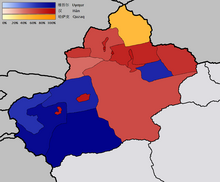 Map showing the distribution of ethnicities in Xinjiang according to census figures from 2000, the prefectures with Uyghur majorities are in blue.
Map showing the distribution of ethnicities in Xinjiang according to census figures from 2000, the prefectures with Uyghur majorities are in blue.Mao declared the founding of the People's Republic of China on 1 October 1949. He turned the Second East Turkistan Republic into the Ili Kazakh Autonomous Prefecture, and appointed Saifuddin Azizi as the region's first Communist Party governor. Many Republican loyalists fled into exile in Turkey and Western countries. The name Xinjiang was changed to Xinjiang Uyghur Autonomous Region, where Uyghurs are the largest ethnicity, mostly concentrated in the south-western Xinjiang.[75]
The Xinjiang conflict is an ongoing separatist conflict in China's far-west province of Xinjiang, whose northern region is known as Dzungaria and whose southern region (the Tarim Basin) is known as East Turkestan. Uyghur separatists and independence movements claim that the Second East Turkestan Republic was illegally incorporated by China in 1949 and has since been under Chinese occupation. Uyghur identity remains fragmented, as some support a Pan-Islamic vision, exemplified by the East Turkestan Islamic Movement, while others support a Pan-Turkic vision, such as the East Turkestan Liberation Organization. A third group would like an East Turkestan state, such as the East Turkestan independence movement. While the East Turkistan Government in Exile strives for the restoration of East Turkistan's independence as a secular pluralistic Republic that guarantees freedom and civil liberties for all people. As a result, "[n]o Uyghur or East Turkestan group speaks for all Uyghurs, although it might claim to", and Uyghurs in each of these camps have committed violence against other Uyghurs who they think are too assimilated to Chinese or Russian society or are not religious enough.[76] Mindful not to take sides, Uyghur "leaders" such as Rebiya Kadeer mainly tried to garner international support for the "rights and interests of the Uyghurs", including the right to demonstrate, although the Chinese government has accused her of orchestrating the deadly July 2009 Ürümqi riots.[77]
Eric Enno Tamm's 2011 book states that, "Authorities have censored Uyghur writers and 'lavished funds' on official histories that depict Chinese territorial expansion into ethnic borderlands as 'unifications (tongyi), never as conquests (zhengfu) or annexations (tunbing)' "[78]
Human rights abuses against Uyghurs in XinjiangSince 2014, Uyghurs in Xinjiang have been affected by extensive controls and restrictions which the Chinese government has imposed upon their religious, cultural, economic and social lives.[79][80][81][82] In Xinjiang, the Chinese government has expanded police surveillance to watch for signs of "religious extremism" that include owning books about Uyghurs, growing a beard, having a prayer rug, or quitting smoking or drinking. The government had also installed cameras in the homes of private citizens.[83][84]
Further, at least 120,000 (and possibly over 1 million)[85] Uyghurs have been detained in mass detention camps,[86] termed "re-education camps", aimed at changing the political thinking of detainees, their identities, and their religious beliefs.[87] Some of these facilities keep prisoners detained around the clock, while others release their inmates at night to return home. According to Chinese government operating procedures, the main feature of the camps is to ensure adherence to Chinese Communist Party ideology. Inmates are continuously held captive in the camps for a minimum of 12 months depending on their performance on Chinese ideology tests.[88] The New York Times has reported inmates are required to "sing hymns praising the Chinese Communist Party and write 'self-criticism' essays," and that prisoners are also subjected to physical and verbal abuse by prison guards.[83] Chinese officials are sometimes assigned to monitor the families of current inmates, and women have been detained due to actions by their sons or husbands.[83]
 Protesters Amsterdam with the Flag of East Turkestan
Protesters Amsterdam with the Flag of East TurkestanIn 2017, Human Rights Watch released a report saying "The Chinese government agents should immediately free people held in unlawful 'political education' centers in Xinjiang, and shut them down."[89] The internment, along with mass surveillance and intelligence officials inserting themselves into Uyghur families, led to widespread accusations of cultural genocide against the CCP. In particular, the size of the operation was found to have doubled over 2018.[90] Satellite evidence suggests China destroyed more than two dozen Uyghur Muslim religious sites between 2016 and 2018.[91]
The government denied the existence of the camps initially, but then changed their stance to claim that the camps serve to combat terrorism and give vocational training to the Uyghur people.[92] Activists have called for the camps to be opened to visitors to prove their function. Media groups have reported that many in the camps were forcibly detained there in rough unhygienic conditions while undergoing political indoctrination.[93] The lengthy isolation periods between Uyghur men and women has been interpreted by some analysts as an attempt to inhibit Uyghur procreation in order to change the ethnic demographics of the country.[94]
An October 2018 exposé by the BBC claimed, based on analysis of satellite imagery collected over time, that hundreds of thousands of Uyghurs were interned in rapidly expanding camps.[95] It was also reported in 2019 that "hundreds" of writers, artists, and academics had been imprisoned, in what the magazine qualified as an attempt to "punish any form of religious or cultural expression" among Uyghurs.[96]
Parallel to the forceful detainment of millions of adults, in 2017 alone at least half a million children were also forcefully separated from their families, and placed in pre-school camps with prison-style surveillance systems and 10,000 volt electric fences.[97]
In 2019, a New York Times article reported that human rights groups and Uyghur activists said that the Chinese government was using technology from US companies and researchers to collect DNA from Uyghurs. They said China was building a comprehensive DNA database to be able to track down Uyghurs who were resisting the re-education campaign.[98] Later that year, satellite photos confirmed the systematic destruction of Uyghur cemeteries.[99][100]
There have been few sustained protests from Islamic countries against the treatment of Uyghurs in China. In December 2018, the Organization of Islamic Cooperation (OIC) initially acknowledged the disturbing reports from the region but it later issued a report saying that the OIC "commends the efforts of the People's Republic of China in providing care to its Muslim citizens; and looks forward to further cooperation between the OIC and the People's Republic of China." Saudi Arabia, which hosts a significant number of ethnic Uyghurs, have refrained from any official criticism of the Chinese government,[101] while Turkey's President Erdogan tacitly supported China saying that "It is a fact that the people of all ethnicities in Xinjiang are leading a happy life amid China's development and prosperity" while visiting China,[102][103][104] after its Foreign Ministry denounced China for "violating the fundamental human rights of Uyghur Turks".[105][106] In 2019, Indonesian scholar Said Aqil Siradj said the situation in Xinjiang was "really good" and suggested that the Indonesian government did not need to follow the Western countries in raising accusations of Uyghur persecution at international forums.[107][108] Some observers have connected the lack of criticism from the Islamic world to Muslim countries' dependence on Chinese economic aid.[109]
In July 2019, 22 countries, including Australia, the United Kingdom, Canada, France, Germany and Japan, raised concerns about "large-scale places of detention, as well as widespread surveillance and restrictions, particularly targeting Uyghurs and other minorities in Xinjiang".[110] The 22 ambassadors urged China to end arbitrary detention and allow "freedom of movement of Uyghurs and other Muslim and minority communities in Xinjiang".[111] However, none of these countries were predominantly Islamic countries.[112] In June 2020, former United States President Donald Trump signed the Uyghur Human Rights Policy Act,[113] which authorizes the imposition of U.S. sanctions against Chinese government officials responsible for re-education camps.[114]
On 12 July 2019, ambassadors from 50 countries issued a joint letter to the President of the UN Human Rights Council and the UN High Commissioner for Human Rights showing their support for China, despite condemnation by several states over the detention of as many as two million Uyghur Muslims. These countries included mainly countries in Asia, Africa and the Middle East.[115][116] On 20 August 2019, Qatar withdrew its signature from the letter, ending its support for China over its treatment of Muslims.[117]
According to a 2020 report by the Australian Strategic Policy Institute (ASPI), several Chinese firms were benefitting from the forced labor of Uyghurs, where more than 80 companies across the world were "directly or indirectly benefiting from the use of Uyghur workers outside Xinjiang through abusive labor transfer programs". While the United States and the United Kingdom had imposed restrictions on imports of cotton and other products from China, Japan was pressured to take action, and 12 major Japanese firms established a policy to cease business with the Chinese firms indicated by the ASPI to be using forced labor of Uyghurs.[118]
In June 2020, German anthropologist Adrian Zenz,[119] released a report alleging that Uyghur women, under the threat of internment, were being forced to abort children, undergo sterilization surgery, and be fitted with intrauterine devices.[120][121] The report revealed that growth rates in Xinjiang had declined 60% between 2015 and 2018,[122] with the two largest Uyghur prefectures declining 84% in that same time period.[123] The birth rate declined a further 24% across the region in 2019 alone compared to the 4.2% drop across all of China in the same year.[122] The report also noted that in 2014, 2.5% of new IUD placements throughout the country were in Xinjiang.[120] By 2018, 80% of new IUD placements were in Xinjiang despite the region comprising 1.8% of the national population.[123] Zenz said that these efforts by China to repress the Uyghur birth rate met the criteria of genocide under Article II, Section D of the United Nations Genocide Convention by "imposing measures intended to prevent births within the group."[122][123] The measures have also been compared to China's past one-child policy targeting its Han population.[124][125] Pundits from Pakistan Observer,[126] Antara,[127] and Detik.com disagreed with allegations of lowered Uyghur births, claiming their birth rate was higher than in earlier years and higher than the Han birth rate.[128]
On July 6, 2020, the East Turkistan Government in Exile and the East Turkistan National Awakening Movement filed a complaint with the International Criminal Court (ICC), urging it to investigate and prosecute PRC officials for genocide and other crimes against humanity.[129][130]
On 13 July 2020, China decided to take reciprocal measures against US officials and announced sanctions on US lawmakers and an envoy over the issue of Uyghur rights in Xinjiang.[131]
In October 2020, 39 countries condemned China's human rights abuses against Uyghurs. Diplomats said some other countries were pressured by China not to join the other 39 countries condemning China's actions.[132] Conversely, 54 countries have voiced their support for China,[133] including North Korea,[132] though one notable country not on either list is South Korea, who has looked to gain political autonomy in recent years by remaining neutral on key contentious issues.[134]
In January 2021, British Foreign Secretary Dominic Raab said that China's treatment of Uyghurs amounts to torture.[135] That same month, the U.S. government declared it a genocide.[136]
On 8 March 2021, the US-based nonpartisan think tank Newlines Institute released what was in their words "the first independent expert application of the 1948 Genocide Convention to the ongoing treatment of the Uyghurs in China." The report concluded "that China is responsible for breaches of each provision of Article II of the Convention" and "bears State responsibility for an ongoing genocide against the Uyghurs, in breach of the Genocide Convention."[137]
In April 2021, Human Rights Watch released a report that labelled the treatment of Uyghurs by the Chinese government as "crimes against humanity".[138]
The treament of Uyghur Muslims in China has resulted in citizens of the ethnic minority group to seek asylum in other nations. A large number of these people chose to confide in the Muslim-majority nations like the United Arab Emirates, Saudi Arabia and Egypt. However, having good ties with China, these countries began detaining and deporting the Uyghur Muslims back to China. Authorities in Dubai and other Islamic countries received extradition requests from Beijing, as per which many exiled Uyghurs were detained, separated from their families and deported to China. Concerns were raised that while western countries like the US were calling it a "genocide", the Muslim-majority countries like the Emirates were ignoring the issue and rather deporting the Uyghurs to China.[139] The Arab nations were focused on the crucial economic ties they maintained with China, which is a primary consumer of Middle East oil and a crucial trading and investment partner for these countries.[140]
On 30 June 2021, a Han Chinese woman, Wu Huan, who was on the run to avoid extradition to China because her fiancé was considered a Chinese dissident, said in an interview that China has a secret jail in Dubai. According to Wu, she was abducted from a hotel in Dubai in late May and detained by Chinese officials for eight days at a villa converted into a jail, where she saw or heard two other prisoners, both Uyghurs. According to Wu, she identified the women as Uyghurs based on what she said was their distinctive appearance and accent. Dubai police denied the presence of any foreign government run detention centers within its borders.[141]
In August 2022, the United Nations released a report alleging that China’s crackdown in Xinjiang may amount to crimes against humanity against the Uyghurs, which included physical and mental torture, forced labor, massive displacement, enforced sterilization and separation of children from their parents. The report was criticized by some activists for not calling the crimes a genocide. Many Uyghurs outside China saw it as a formal acknowledgement of the sufferings of Uyghurs in China, hoping it will add fuel to their campaign at the international level.[142][143]
^ Gardner Bovingdon (2010). "Chapter 1 – Using the Past to Serve the Present". The Uyghurs – strangers in their own land. Columbia University Press. ISBN 978-0-231-14758-3. ^ a b Nabijan Tursun. "The Formation of Modern Uyghur Historiography and Competing Perspectives toward Uyghur History". The China and Eurasia Forum Quarterly. 6 (3): 87–100. Archived from the original on 24 May 2013. ^ "Brief History of East Turkestan". World Uyghur Congress. Archived from the original on 6 March 2016. ^ Information Office of the State Council of the People's Republic of China (2004). "History and Development of Xinjiang". Chinese Journal of International Law. 3 (2): 629–659. doi:10.1093/oxfordjournals.cjilaw.a000538. ^ Ildikó Bellér-Hann (2007). Situating the Uyghurs between China and Central Asia. Ashgate Publishing, Ltd. p. 32. ISBN 978-0-7546-7041-4. ^ a b c d Cite error: The named reference xinjiang was invoked but never defined (see the help page). ^ Susan J. Henders (2006). Susan J. Henders (ed.). Democratization and Identity: Regimes and Ethnicity in East and Southeast Asia. Lexington Books. p. 135. ISBN 978-0-7391-0767-6. Retrieved 9 September 2011. ^ Reed, J. Todd; Raschke, Diana (2010). The ETIM: China's Islamic Militants and the Global Terrorist Threat. ABC-CLIO. p. 7. ISBN 978-0313365409. Archived from the original on 1 January 2016. Retrieved 22 September 2015. ^ Millward 2007, p. 44. ^ Millward 2007, p. 14. ^ A. K Narain (March 1990). "Chapter 6 – Indo-Europeans in Inner Asia". In Denis Sinor (ed.). The Cambridge History of Early Inner Asia. p. 153. ISBN 978-0-521-24304-9. ^ David W. Anthony, "Two IE phylogenies, three PIE migrations, and four kinds of steppe pastoralism", Journal of Language Relationship, vol. 9 (2013), pp. 1–22 ^ Zhang, F; Ning, C; Scott, A; et al. (2021). "The genomic origins of the Bronze Age Tarim Basin mummies". Nature. 599 (7884): 256–261. Bibcode:2021Natur.599..256Z. doi:10.1038/s41586-021-04052-7. PMC 8580821. PMID 34707286. ^ Gardner Bovingdon (2004). "Chapter 14 – Contested histories". In S. Frederick Starr (ed.). Xinjiang, China's Muslim Borderland. pp. 357–358. ISBN 978-0-7656-1318-9. ^ Unterländer, Martina; Palstra, Friso; Lazaridis, Iosif; Pilipenko, Aleksandr; Hofmanová, Zuzana; Groß, Melanie; Sell, Christian; Blöcher, Jens; Kirsanow, Karola; Rohland, Nadin; Rieger, Benjamin (3 March 2017). "Ancestry and demography and descendants of Iron Age nomads of the Eurasian Steppe". Nature Communications. 8: 14615. Bibcode:2017NatCo...814615U. doi:10.1038/ncomms14615. ISSN 2041-1723. PMC 5337992. PMID 28256537. ^ Millward 2007, pp. 13, 29. ^ Mallory, J. P.; Mair, Victor H. (2000). The Tarim Mummies: Ancient China and the Mystery of the Earliest Peoples from the West. London: Thames & Hudson. pp. 77–81. ^ Smith, Vincent A. (1999). The Early History of India. Atlantic Publishers. p. 193. ISBN 978-8171566181. ^ Golden 1992, p. 155. ^ Wechsler, Howard J. (1979). "T'ai-tsung (reign 624–49) the consolidator". In Twitchett, Denis (ed.). Sui and T'ang China, 589–906, Part 1. The Cambridge History of China. Vol. 3. Cambridge University Press. p. 228. ISBN 978-0-521-21446-9. ^ Mallory, J.P. (2015), "The problem of Tocharian origins: an archaeological perspective" (PDF), Sino-Platonic Papers (259): 273 ^ a b Robbeets 2017, pp. 216–218. ^ Robbeets 2020. ^ Nelson et al. 2020. ^ Li et al. 2020. ^ Uchiyama et al. 2020. ^ Damgaard et al. 2018, pp. 4–5. "These results suggest that Turkic cultural customs were imposed by an East Asian minority elite onto central steppe nomad populations... The wide distribution of the Turkic languages from Northwest China, Mongolia and Siberia in the east to Turkey and Bulgaria in the west implies large-scale migrations out of the homeland in Mongolia. ^ Lee & Kuang 2017, p. 197. "Both Chinese histories and modern dna studies indicate that the early and medieval Turkic peoples were made up of heterogeneous populations. The Turkicisation of central and western Eurasia was not the product of migrations involving a homogeneous entity, but that of language diffusion." ^ Golden 1992, p. 157. ^ "Full Text of White Paper on History and Development of Xinjiang". en.people.cn. Archived from the original on 25 June 2019. Retrieved 15 June 2019. ^ 新唐書/卷217下 – 維基文庫,自由的圖書館 [New Tang Book/Volume 217 - Wikisource, the free online library]. zh.wikisource.org (in Chinese). Archived from the original on 12 May 2013.[full citation needed] ^ Dust in the Wind: Retracing Dharma Master Xuanzang's Western Pilgrimage. Rhythms Monthly. 2006. p. 480. ISBN 9789868141988. ^ a b c Millward 2007, p. 69 ^ Golden, Peter. B. (1990), "The Karakhanids and Early Islam", in Sinor, Denis (ed.), The Cambridge History of Early Inner Asia, Cambridge University Press, p. 357, ISBN 0-521-2-4304-1 ^ "Uyghur-History-in-Britanica". www.scribd.com. Archived from the original on 4 January 2020. Retrieved 20 February 2013. ^ Hamilton Alexander Rosskeen Gibb; Bernard Lewis; Johannes Hendrik Kramers; Charles Pellat; Joseph Schacht (1998). The Encyclopaedia of Islam. Brill. p. 677. Archived from the original on 1 January 2016. Retrieved 21 August 2015. ^ "北京保利国际拍卖有限公司". www.polypm.com.cn. ^ Christian Tyler (2004). Wild West China: The Taming of Xinjiang. Rutgers University Press. p. 55. ISBN 978-0813535333. ^ Millward 2007, p. 101. ^ Newby, L. J. (1998). "The Begs of Xinjiang: Between Two Worlds". Bulletin of the School of Oriental and African Studies, University of London. Cambridge University Press on behalf of School of Oriental and African Studies. 61 (2): 278–297. doi:10.1017/s0041977x00013811. JSTOR 3107653. S2CID 153718110. ^ Perdue 2009 Archived 1 January 2016 at the Wayback Machine, p. 285. ^ Tamm, Eric Enno (10 April 2011). The Horse That Leaps Through Clouds: A Tale of Espionage, the Silk Road and the Rise of Modern China. Catapult. ISBN 9781582438764. Archived from the original on 1 January 2016. Retrieved 24 July 2020 – via Google Books. ^ ed. Starr 2004 Archived 12 February 2019 at the Wayback Machine, p. 243. ^ Millward 1998 Archived 1 January 2016 at the Wayback Machine, p. 102. ^ Tyler 2004 Archived 1 January 2016 at the Wayback Machine, p. 4. ^ a b c Liu, Tao Tao; Faure, David (1996). Unity and Diversity; Local Cultures and Identity in China. University of Hong Kong Press. ISBN 978-9622094024. Archived from the original on 13 July 2018. Retrieved 4 June 2018. ^ Samuel Wells Williams (1848). The Middle Kingdom: A Survey of the Chinese Empire and Its Inhabitants. Wiley and Putnam. p. 64. Retrieved 8 May 2011. ^ Millward, James A. (1998). Beyond the Pass: Economy, Ethnicity, and Empire in Qing Central Asia, 1759–1864. Stanford University Press. p. 124. ISBN 0804797927. ^ Millward, James A. (1998). Beyond the Pass: Economy, Ethnicity, and Empire in Qing Central Asia, 1759-1864. Stanford University Press. pp. 206–207. ISBN 0804797927. ^ Millward 2007, p. 108. ^ Millward 2007, p. 109. ^ 烏什庫車阿克蘇等城回目 ^ 烏什庫車阿克蘇等處回人 ^ 安西廳哈密回民 ^ 伊犂塔勒奇察罕烏蘇等處回人 ^ Millward, James A. (1998). Beyond the Pass: Economy, Ethnicity, and Empire in Qing Central Asia, 1759–1864 (illustrated ed.). Stanford University Press. p. 21. ISBN 978-0804729338. Archived from the original on 4 July 2014. Retrieved 10 March 2014. ^ Kim, Hodong (2004). Holy War in China: The Muslim Rebellion and State in Chinese Central Asia, 1864–1877 (illustrated ed.). Stanford University Press. p. 15. ISBN 978-0804767231. Retrieved 10 March 2014. ^ Millward, James A. (1998). Beyond the Pass: Economy, Ethnicity, and Empire in Qing Central Asia, 1759-1864 (illustrated ed.). Stanford University Press. p. 23. ISBN 978-0804729338. Archived from the original on 4 July 2014. Retrieved 10 March 2014. ^ Christian Tyler (2004). Wild West China: The Taming of Xinjiang. Rutgers University Press. p. 56. ISBN 978-0813535333. ^ Inner Asia, Volume 4, Issues 1-2. The White Horse Press for the Mongolia and Inner Asia Studies Unit at the University of Cambridge. 2002. p. 127. Retrieved 10 March 2014. ^ Starr, S. Frederick (2015). Xinjiang: China's Muslim Borderland. Taylor & Francis. p. 76. ISBN 9781317451372. Retrieved 25 March 2021. ^ Ercilasun, Güljanat Kurmangaliyeva (November 2017). The Uyghur Community: Diaspora, Identity and Geopolitics. Palgrave Macmillan US. p. 41. ISBN 9781137522979. Retrieved 25 March 2021. ^ a b Starr, S. Frederick (2015). Xinjiang: China's Muslim Borderland. United States: Taylor & Francis. p. 80. ISBN 9781317451372. Retrieved 25 March 2021. ^ Starr, S. Frederick (2015). Xinjiang: China's Muslim Borderland. Taylor & Francis. p. 81. ISBN 9781317451372. Retrieved 25 March 2021. ^ Benson, Linda (1990). The Ili Rebellion: The Moslem Challenge to Chinese Authority in Xinjiang, 1944–1949. M.E. Sharpe. p. 265. ISBN 9780873325097. Retrieved 25 March 2021. ^ Kamalov, Ablet (2010). Millward, James A.; Shinmen, Yasushi; Sugawara, Jun (eds.). Uyghur Memoir literature in Central Asia on Eastern Turkistan Republic (1944–49). Studies on Xinjiang Historical Sources in 17–20th Centuries. Tokyo: The Toyo Bunko. p. 260. ^ Ondřej Klimeš (8 January 2015). Struggle by the Pen: The Uyghur Discourse of Nation and National Interest, c.1900–1949. BRILL. pp. 197–. ISBN 978-90-04-28809-6. ^ Benson, Linda (1991). "Uygur Politicians of the 1940s: Mehmet Emin Bugra, Isa Yusuf Alptekin and Mesut Sabri∗". Central Asian Survey. 10 (4): 87. doi:10.1080/02634939108400758. ^ "The Soviet-Sponsored Uprising in Kuldja/The East Turkestan People's Republic" (PDF). Central Intelligence Agency. Retrieved 25 March 2021. ^ Malhotra, Iqbal Chand (November 2020). Red Fear: The China Threat. Bloomsbury Publishing. p. 356. ISBN 9789389867596. Retrieved 25 March 2021. ^ Urban, Madison (16 October 2020). "21st Century Crimes Against Humanity: Oppression of the Uyghurs in China". Carolina Political Review. Retrieved 25 March 2021. ^ Sanchez, Alejandro (30 December 2019). "Business as Usual with Beijing as Uyghurs Languish in "Education Camps"". Geopolitical Monitor. Retrieved 25 March 2021. ^ "Second East Turkistan Republic (1944–1949)". East Turkistan Government in Exile. 4 March 2021. Retrieved 25 March 2021. ^ 中華人民共和國國家統計局 關於一九九○年人口普查主要數據的公報 (第三號). National Bureau of Statistics of China. Archived from the original on 10 May 2012. 維吾爾族 7214 431人 ^ 2000年人口普查中國民族人口資料 [2000 Population Census Chinese Ethnic Population Data] (in Simplified Chinese). 民族出版社. 2003. ISBN 978-7-105-05425-1. ^ Christofferson, Gaye (September 2002). "Constituting the Uyghur in U.S.-China Relations: The Geopolitics of Identity Formation in the War on Terrorism". Strategic Insights. Center for Contemporary Conflict. 1 (7). ^ Hongmei, Li (7 July 2009). "Unveiled Rebiya Kadeer: a Uighur Dalai Lama". People's Daily. Archived from the original on 9 January 2010. Retrieved 21 August 2010. ^ Enno, Tamm, Eric (2011). The horse that leaps through clouds: a tale of espionage, the Silk Road, and the rise of modern China. Berkeley, CA: Counterpoint Press. pp. 194. ISBN 9781582437347. OCLC 663952959. Yet the Uyghurs have stubbornly resisted the Chinese Communist Party's ideological claims, Bovingdon writes, in 'an enduring struggle over history that is also a battle' over the future of their land and their own fate. ^ "China has turned Xinjiang into a police state like no other". The Economist. 31 May 2018. Archived from the original on 5 June 2018. ^ "China: one in five arrests take place in 'police state' Xinjiang". The Guardian. 25 July 2018. Archived from the original on 4 January 2019. ^ "China has turned Xinjiang into a police state like no other". Der Spiegel. 26 July 2018. Archived from the original on 4 January 2019. ^ Haitiwaji, Gulbahar; Morgat, Rozenn (12 January 2021). "How I survived a Chinese 're-education' camp for Uighurs". The Guardian. Retrieved 12 January 2021. [As] new graduates, had begun looking for work. This was in 1988. In the job ads in the newspapers, there was often a little phrase in small print: No Uighurs. ... We were lucky [to find work]. But then there was the red envelope episode. At lunar new year, when the boss handed out the annual bonuses, the red envelopes given to Uighur workers contained less than those given to our colleagues who belonged to China's dominant ethnic group, the Han. Soon after, all the Uighurs were transferred out of the central office and moved to the outskirts of town. ^ a b c Buckley, Chris (8 September 2018). "China Is Detaining Muslims in Vast Numbers. The Goal: 'Transformation.'". The New York Times. Archived from the original on 8 September 2018. Retrieved 9 September 2018. ^ Mozur, Paul (14 April 2019). "One Month, 500,000 Face Scans: How China Is Using A.I. to Profile a Minority". The New York Times. ISSN 0362-4331. Archived from the original on 8 June 2019. Retrieved 9 June 2019. ^ Thum, Rian (22 August 2018). "China's Mass Internment Camps Have No Clear End in Sight". Foreign Policy. Archived from the original on 5 May 2019. Retrieved 26 August 2018. The most widely circulated estimate of the number of people interned in re-education camps—several hundred thousand to just over 1 million—was developed by Adrian Zenz of the European School of Culture and Theology from leaks that surfaced in January and February. ^ "China 'holding at least 120,000 Uighurs in re-education camps'". The Guardian. 25 January 2018. Archived from the original on 19 August 2018. Retrieved 4 August 2018. ^ "Chinese mass-indoctrination camps in Muslim-majority Xinjiang evoke Cultural Revolution". abc.net.au. 17 May 2018. Archived from the original on 11 July 2018. Retrieved 25 June 2018. ^ "China Cables". ICIJ. Retrieved 24 November 2019. ^ "China: Free Xinjiang 'Political Education' Detainees". www. hrw.org. 10 September 2017. Retrieved 10 September 2017. ^ Cronin-Furman, Kate (19 September 2018). "China Has Chosen Cultural Genocide in Xinjiang—For Now". Foreign Policy. Retrieved 20 September 2018. ^ Cite error: The named reference lily was invoked but never defined (see the help page). ^ Ramzy, Austin; Buckley, Chris (16 November 2019). "'Absolutely No Mercy': Leaked Files Expose How China Organized Mass Detentions of Muslims". The New York Times. ISSN 0362-4331. Retrieved 16 November 2019. ^ "Xinjiang Authorities Holding Hundreds From Kyrgyz Village in 'Political' Re-education Camps". Radio Free Asia. Archived from the original on 11 December 2018. Retrieved 10 December 2018. ^ Yi, Lin (29 January 2016). "A Failure in 'Designed Citizenship': A Case Study in a Minority-Han Merger School in Xinjiang Uyghur Autonomous Region". Japanese Journal of Political Science. 17 (1): 22–43. doi:10.1017/S1468109915000377. ^ Sudworth, John (24 October 2018). "China's hidden camps". BBC. Archived from the original on 5 January 2019. Retrieved 17 February 2019. ^ "Movius, Lisa. "'Hundreds' of cultural figures caught up in China's Uyghur persecution". The Art Newspaper. Archived from the original on 2 January 2019. Retrieved 3 January 2019. ^ Sudworth, John (4 July 2019). "China separating Muslim children from families". BBC News. Archived from the original on 5 July 2019. Retrieved 5 July 2019. ^ Wee, Sui-Lee (21 February 2019). "China Uses DNA to Track Its People, With the Help of American Expertise". The New York Times. Archived from the original on 21 February 2019. ^ "Then and now: China's destruction of Uighur burial grounds". The Guardian. 2019. Retrieved 4 January 2020. China is destroying Uighur graveyards where generations of families have been laid to rest, leaving behind human bones and broken tombs in what activists call an effort to eradicate the ethnic group's identity in Xinjiang ^ "'Pure evil': Satellites show destroyed Uyghur graves in China". CNN. 2 January 2020. Archived from the original on 28 October 2021. Retrieved 4 January 2020 – via YouTube. ^ Ma Alexandra (April 2019). A wave of Islamic countries started to stand up to China over its persecution of its Muslim minority. But then they all got spooked. Archived 23 April 2019 at the Wayback Machine Business Insider. Retrieved 17 May 2019. ^ "China says Turkey president offered support over restive Xinjiang". Reuters. 2 July 2019. Retrieved 5 July 2019. ^ "Erdogan says Xinjiang camps shouldn't spoil Turkey-China relationship". CNN International. 2 July 2019. Retrieved 5 July 2019. ^ Ma, Alexandra (6 July 2019). "The last major opponent of China's Muslim oppression has retreated into silence. Here's why that's a big deal". Business Insider. Retrieved 18 August 2019. ^ "Why Is Turkey Breaking Its Silence on China's Uyghurs?". The Diplomat. 12 February 2019. ^ "From Rep. of Turkey Ministry of Foreign Affairs". Republic of Turkey Ministry of Foreign Affairs. Archived from the original on 11 February 2019. Retrieved 16 August 2019. ^ Drs H. Agus Fathuddin Yusuf MA (28 September 2020). "Isu Xinjiang Terus Digoreng Bagian dari Perang Dagang". Detik.com (in Indonesian). Archived from the original on 22 November 2022. ^ Fathuddin, Agus (19 July 2019). "PBNU Yakin Tidak Ada Kekerasan Etnis Uighur dan Muslim Xinjiang" [PBNU Confident There Is No Ethnic Violence Of Uyghurs And Xinjiang Muslims]. Suara Merdeka (in Indonesian). Retrieved 22 November 2022. ^ Berman, Ilan (15 June 2020). "China Outmaneuvers the Muslim World". The Diplomat. Retrieved 10 April 2021. ^ "More than 20 ambassadors condemn China's treatment of Uighurs in Xinjiang". The Guardian. Archived from the original on 11 July 2019. Retrieved 11 July 2019. ^ "China 'hopping mad' as 22 countries sign UN letter on Uighur Muslims". Sky News. Archived from the original on 11 July 2019. Retrieved 11 July 2019. ^ Ma, Alexandra (12 July 2019). "22 countries signed an 'unprecedented' letter condemning China's oppression of Muslims. But none of them come from the Islamic world". Business Insider. Retrieved 11 November 2019. ^ "Trump signed a law to punish China for its oppression of the Uighur Muslims. Uighurs say much more needs to be done". Business Insider. 30 June 2020. ^ "U.S. Congress urges Trump administration to get tougher on China's Xinjiang crackdown". Reuters. 2 July 2020. ^ "A letter praising 'counter-terrorism' program in Xinjiang from 37 countries". Sup China. 16 July 2019. Retrieved 16 July 2019. ^ Yellienk, Roie. "The "22 vs. 50" Diplomatic Split Between the West and China Over Xinjiang and Human Rights". Jamestown. Retrieved 8 May 2020. ^ "Qatar refuses to certify China's human rights record on treatment of Uighur Muslims". ThePrint. 21 August 2019. Retrieved 21 August 2019. ^ "12 Japanese firms will end business deals involving Uyghur forced labor". The Japan Times. 22 February 2021. Retrieved 22 February 2021. ^ Chin, Josh (21 May 2019). "The German Data Diver Who Exposed China's Muslim Crackdown". The Wall Street Journal. ISSN 0099-9660. Retrieved 23 March 2021. ^ a b Zenz, Adrian (27 June 2020). "Sterilizations, IUDs, and Mandatory Birth Control: The CCP's Campaign to Suppress Uyghur Birthrates in Xinjiang" (PDF). The Jamestown Foundation. Archived from the original (PDF) on 29 June 2020. Retrieved 29 June 2020. ^ "China forcing birth control on Uighurs to suppress population, report says". BBC News. 29 June 2020. Archived from the original on 29 June 2020. Retrieved 29 June 2020. ^ a b c Dunleavy, Jerry (29 June 2020). "'Demographic genocide': Analysis explores China's campaign of forced birth control and abortion against Uighurs". Washington Examiner. Archived from the original on 29 June 2020. Retrieved 29 June 2020. ^ a b c Lipes, Joshua (29 June 2020). "Forced Population Controls Targeting Uyghurs in Xinjiang Likely Amount to Genocide: Report". Radio Free Asia. Archived from the original on 29 June 2020. Retrieved 29 June 2020. ^ Piotrowicz, Ryszard (14 July 2020). "Legal expert: forced birth control of Uighur women is genocide – can China be put on trial?". The Conversation. Aberystwyth University. ^ Victor Ordonez (8 June 2021). "Chinese birth-control policy could cut millions of Uyghur births: Report". ABC News. ^ "Experts reject US allegations of genocide in Xinjiang, China". Pakistan Observer. 25 September 2021. ^ Cite error: The named reference :3 was invoked but never defined (see the help page). ^ Basuki, Novi (20 December 2021). "Uighur dan Pemboikotan Olimpiade Beijing" [Uighurs and the Boycott of the Beijing Olympics]. Detik.com (in Indonesian). Archived from the original on 20 July 2022. Retrieved 20 July 2022. ^ Simons, Marlise (6 July 2020). "Uighur Exiles Push for Court Case Accusing China of Genocide". The New York Times. New York Times. Archived from the original on 6 July 2020. Retrieved 24 July 2020. ^ Areddy, James T. (6 July 2020). "Representatives of China's Uighurs File Evidence to International Criminal Court". The Wall Street Journal. Retrieved 24 July 2020. ^ "China slaps tit-for-tat sanctions on US officials over Uighur rights". Anadolu Agency. Retrieved 13 July 2020. ^ a b Besheer, Margaret (6 October 2020). "At UN: 39 Countries Condemn China's Abuses of Uighurs". Voice of America. ^ Tiezzi, Shannon (9 October 2020). "Which Countries Support China on Hong Kong's National Security Law?". The Diplomat. ^ Snyder, Scott A. (March 2020). South Korea at the Crossroads Autonomy and Alliance in an Era of Rival Powers. Columbia University Press. ISBN 9780231546188. ^ Wintour, Patrick (12 January 2021). "China's treatment of Uighurs amounts to torture, says Dominic Raab". The Guardian. Retrieved 12 January 2021. ^ Pompeo, Mike (19 January 2021). "Genocide in Xinjiang". The Wall Street Journal. Retrieved 19 January 2021. ^ "The Uyghur Genocide: An Examination of China's Breaches of the 1948 Genocide Convention". Newlines Institute. 9 March 2021. Retrieved 9 March 2021. ^ ""Break Their Lineage, Break Their Roots": China's Crimes against Humanity Targeting Uyghurs and Other Turkic Muslims". Human Rights Watch. 19 April 2021. ^ "Uyghurs are being deported from Muslim countries, raising concerns about China's growing reach". CNN International. 8 June 2021. Retrieved 8 June 2021. ^ "Why do some Muslim-majority countries support China's crackdown on Muslims?". The Washington Post. Retrieved 4 May 2021. ^ "Detainee says China has secret jail in Dubai, holds Uyghurs". Associated Press. 16 August 2021. Retrieved 16 August 2021. ^ Ramzy, Austin (1 September 2022). "For Uyghurs, U.N. Report on China's Abuses Is Long-Awaited Vindication". The New York Times. Retrieved 2 September 2022. ^ "China: New UN Report Alleges Crimes Against Humanity". Human Rights Watch. 31 August 2022. Retrieved 2 September 2022.
Cite error: There are <ref group=note> tags on this page, but the references will not show without a {{reflist|group=note}} template (see the help page).

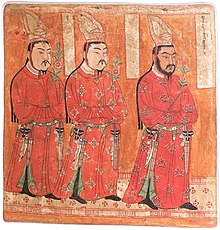





![Uyghur chieftain from Wushi, Kucha and Aksu, with his wife. Huang Qing Zhigong Tu, 1769.[52]](http://upload.wikimedia.org/wikipedia/commons/thumb/a/aa/Huang_Qing_Zhigong_Tu%2C_1769%2C_Uyghur_chieftain_from_Ush%2C_Kucha_and_Aksu%2C_with_his_wife.jpg/171px-Huang_Qing_Zhigong_Tu%2C_1769%2C_Uyghur_chieftain_from_Ush%2C_Kucha_and_Aksu%2C_with_his_wife.jpg)
![Uyghur commoners from Wushi, Kucha and Aksu. Huang Qing Zhigong Tu, 1769.[53]](http://upload.wikimedia.org/wikipedia/commons/thumb/8/87/Huang_Qing_Zhigong_Tu%2C_1769%2C_Uyghur_commoners_from_Ush%2C_Kucha_and_Aksu.jpg/165px-Huang_Qing_Zhigong_Tu%2C_1769%2C_Uyghur_commoners_from_Ush%2C_Kucha_and_Aksu.jpg)
![Uyghur people from Hami, in Anxi subprefecture. Huang Qing Zhigong Tu, 1769.[54]](http://upload.wikimedia.org/wikipedia/commons/thumb/2/2c/Huang_Qing_Zhigong_Tu%2C_1769%2C_Uyghur_people_from_Hami_in_Anxi_subprefecture.jpg/156px-Huang_Qing_Zhigong_Tu%2C_1769%2C_Uyghur_people_from_Hami_in_Anxi_subprefecture.jpg)
![Uyghur people from Ili, Taleqi, Chahan and Wusu. Huang Qing Zhigong Tu, 1769.[55]](http://upload.wikimedia.org/wikipedia/commons/thumb/e/e3/Huang_Qing_Zhigong_Tu%2C_1769%2C_Uyghur_from_Ili%2C_Taleqi%2C_Chahan_and_Wusu%2C_with_his_wife.jpg/175px-Huang_Qing_Zhigong_Tu%2C_1769%2C_Uyghur_from_Ili%2C_Taleqi%2C_Chahan_and_Wusu%2C_with_his_wife.jpg)














